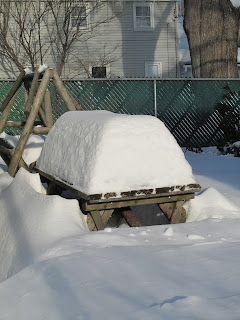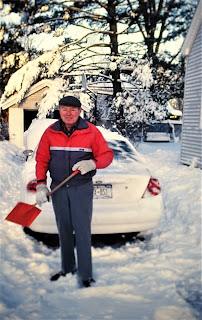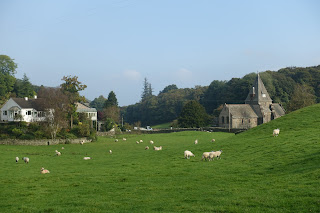I am finding that my parents' old-age issues are making me more nostalgic than usual, so I am posting a piece from 2003. This is a chapter from my book "Cool Mom on the Hot Seat" (2005). My best wishes to everyone for a very Merry Christmas.
-------------------------------------------------------------------------
Snow Descending
I
called my parents on Christmas Eve. “Come tonight,” I said. “Or
at least when you come on Christmas bring overnight clothes. I
really want you to be here and the forecast is for a huge snowstorm.”
After
consulting with my mother, my father called back. “We’ll beat
the storm and come tomorrow morning between 7 and 7:15 and we’ll
plan to stay overnight if we have
to.”
I told the family about the plans.
I told the family about the plans.
Daniel,
my twenty-one year old nephew, asked hesitantly, “Grandma and
Grandpa are coming by 7:30?”
Thomas
joined in. “I better prepare myself for Grandpa’s excitement
that early in the morning.”
I
laughed. “Hey you guys, a few years ago you would have been
thrilled to have them here for breakfast.”
“We
didn’t care about sleep then,” Daniel said with a sheepish grin.
My
seventy-eight year old father would be excited about Christmas and
excited about the snow. He would have been up since 6 a.m. and would
likely enter our house with a rousing, “ho, ho, ho.”
Despite his concern, Daniel slept through my parents’ arrival on Christmas morning and we had a family breakfast by 8:30 without him. At 11:00, Carolyn arrived in a snow shower. By noon the flakes fell hard and fast, and we were glad to see Bill’s sister, Mary Jo, and her family arrive.
Now
with twelve for cocktails, gifts, dinner and dessert, voices filled
our little house and we tripped over each other in the kitchen. The
windows steamed up from warmth and cooking so it was easy to ignore
the deepening snow until dinner was over. Estimates began on how
much had accumulated.
“Only
about three inches,” my father said.
“I think there’s more,” Michael, Mary Jo’s husband, guessed. He opened the front door and the two of them stuck their heads out surveying the white atmosphere. Like the uncles in Dylan Thomas’s A Child’s Christmas in Wales, the men discussed the issue from the comfort of the living room.
Carolyn said, “The snow is getting heavier. I
think I better go home.”
Staying
overnight was not an option for her. Not only was she allergic to
our cat, but she had to be home because her younger children were
scheduled to be at her house early the next day. We hated the
thought of her driving alone into near zero visibility and were
relieved when she called to say that she had gotten home safely.
As the
snow deepened, Mary Jo and her family prepared to leave at 5:30. The
snow came down so fast that she and Michael no sooner cleaned off one
side of the car than the other was covered again. At 6:00 Thomas’s
girlfriend, Marliese, arrived, dropped off by her father who had had
to take a relative home nearby.
With the
onset of evening, we began kitchen cleanup. Bill put food away and
then
went outside to shovel, giving the driveway its first pass. My
mother and I washed and dried the dishes while Meredith made endless
trips from the kitchen to the dining room carrying the dirty plates
in and the cleans one back. The others watched a new DVD in the
basement family room.
After
the kitchen was cleaned up, snacking began. Rolls, desserts,
cookies, and candy disappeared. Late night munching on turkey
sandwiches was out of the question. Only scraps remained from the
twenty-pound bird we had cooked that day.
I
said, “I’m going to sit down a few minutes, and then I’m going
outside to shovel.”
“Me
too,” Meredith said.
At
10:00 p.m., Meredith measured seventeen inches on the untouched
sidewalk.
An additional eight or nine had fallen on the driveway since Bill had shoveled. We cleared the sidewalks and driveway, put the shovels away, and headed to the back door.
An additional eight or nine had fallen on the driveway since Bill had shoveled. We cleared the sidewalks and driveway, put the shovels away, and headed to the back door.
“Let’s
make snow angels,” Meredith said.
“I
don’t want to,” I answered. “I’m already pretty snowy.”
“It’s
Christmas. You have to.”
We lay side by side in the back yard and after each of us made an angel, we brushed off our clothes and went inside.
By
10:30, we felt snug in the warmth of the house and the Christmas
lights. I carried a pile of sheets and quilts to the futon in the
basement to make a bed for my parents and told Marliese, “You
should probably stay overnight too.”
“Oh
no,” she said. “I called my dad. He’ll be over. I can’t
stay. I have to have my medicine.”
Marliese
would suffer stomach pain unless she took medication for a chronic
ailment.
She
exchanged a few phone calls with her parents and said, “My dad is
stuck at the corner of our street. And the plow came and it got
stuck too! My mom told me not to try to get home.”
“Maybe
we should snowshoe over for her medicine,” I said.
“I
could do that,” Thomas said.
Marliese
lived a half mile away. She laughed. “I’ll be fine.”
“I
don’t want you to feel sick.” I told her.
“It
takes a while. It won’t hit me for a day or two.”
Meredith
leapt at the idea of snowshoeing. “Let’s, Mom, it’ll be fun.”
“You
don’t have to do that,” Marliese insisted.
“We
could just go around the yard and see how we do,” I suggested,
knowing full well that we would go to Marliese’s house.
In
deep snow and darkness Meredith and I trudged on snowshoes through
the field at the end of our street and up Central Avenue.
Cars
passed slowly on the white road.
“Merry
Christmas,” one driver shouted.
“Way
to go!” Another driver gave us the thumbs up.
“This
is cool,” Meredith said.
“Yeah,
we’re like Saint Bernards on a rescue mission.”
When
we reached Marliese’s house, her father’s car stood crossways in
the street. Distracted by the struggle to move it, her mother went
into the house and brought us the medicine with little conversation.
Meredith and I headed home taking side streets. A car, bumper deep
and stuck in the middle of the street, held four laughing young
people.
“Merry
Christmas,” I called to them.
A man
going over to dig out the stranded car shouted, “Same to you.”
A
woman shoveled nearby and a man holding a beer laughed and said,
“What else
have we
got to do? It’s nice out here.”
We
walked past houses lit with colored lights and past people pushing
snow blowers or shoveling. Shouts of “Merry Christmas” filled
the air.
Returning
to our house by 11:30 p.m., we set up sleeping arrangements for my
parents in the family room downstairs, Thomas and Daniel in sleeping
bags in front of the tree in the living room, Marliese in Thomas’s
room upstairs, and Bill and I and Meredith in our own rooms.
My
mother surveyed the futon in the glow of the nightlight. “It looks
pretty cozy,” she said.
Our
house was filled with sleepers top to bottom.
The next morning the snow measured twenty-one inches. Our two snow angels in the backyard had an ethereal softness from the snow that had fallen in the hours since we had made them. Inside, the Christmas coffeecake vanished. After a quick breakfast, my father cleaned off his car. Daniel dug his out from where the plow had pushed five-foot banks against it. Thomas shoveled out the neighbors, and Bill and I, once again, cleaned off our driveway and sidewalk. At 10:00, my parents were the first to leave.
By
1:00 p.m. on December 26, our last guest had departed. The cluttered
kitchen counters showed evidence of two days of cooking and feasting.
The living room was an obstacle course of rolled up sleeping bags,
camping mats, empty boxes, stray wrappings, tray tables, and extra
chairs. In the dining room, the extended table covered with dishes
to be put away and the little children’s table stood amidst twelve
chairs, all askew. Even the second floor and the basement did not
escape the chaos. They became repositories for anything that had no
place else to go. We had had a storybook holiday of snow,
excitement, food, family and friends.
Eventually, the time came to put the inside of the house back in order. But first, I sat on the warm radiator and looked out the front window at the mounds of white. As Dylan Thomas had written: “Our snow was not only shaken from whitewash buckets down the sky, it came shawling out of the ground and swam and drifted out of the arms and hands and bodies of the trees; snow grew overnight on the roofs of the houses like a pure and grandfather moss.”

























































